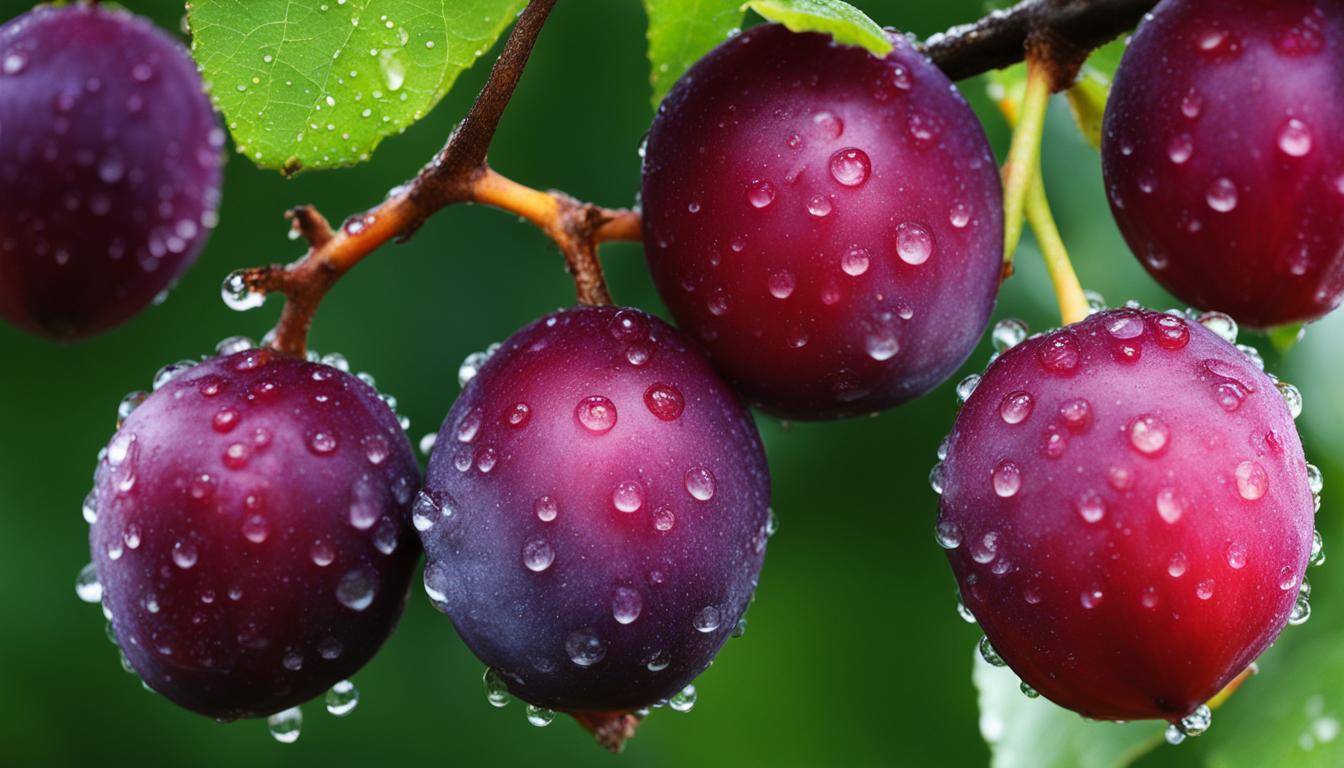Treat your senses to the joy of plumcots, a special fruit blend. These fruits mix plums’ sweetness with apricots’ tartness. They shine in vibrant hues and juicy goodness, standing out in the stone fruit family.
Enjoy their rich flavor by eating them fresh, baking delicious desserts, or making smoothies. Plumcots come in red, purple, and yellow, making your meals both tasty and pretty.
Growing from plumcot trees, a cross between plum and apricot trees, they add more excitement. Having these trees in your garden is rewarding. You’ll love eating fruits straight from your backyard.
Key Takeaways:
- Plumcots are a hybrid fruit combining the traits of plums and apricots.
- They offer a sweet and tangy flavor, making them perfect for snacking and culinary creations.
- Plumcots come in a variety of colors, adding visual appeal to any dish.
- These fruits are grown on plumcot trees, a combination of plum and apricot trees.
- Plumcots are a versatile and delightful addition to any diet.
Plumcot – A Nutritional Powerhouse
Plumcots taste great and are full of nutrients. They have lots of vitamins and minerals important for health.
Vitamins for Immunity and Healthy Skin
Plumcots offer plenty of vitamin C. This nutrient boosts immunity and helps make collagen. It fights off free radicals and keeps skin healthy.
Vitamin A for Vision and Skin Health
Vitamin A is another benefit of plumcots. It’s essential for clear vision and skin health. Eating plumcots can support your vision and skin.
Potassium for Heart Health
Plumcots have potassium, which is vital for the heart. It helps control blood pressure. Adding them to your diet supports heart health.
Fiber for Digestion and Satiety
Plumcots are rich in fiber, which is great for digestion. Fiber helps you stay full and maintain a healthy weight.
Eating plumcots regularly offers many health benefits. Enjoy them fresh, in recipes, or in smoothies. They’re tasty and good for you.
The Origin of Plumcots
Plumcots have a fascinating start. Early 20th-century botanists created them. They crossed plums with apricots.
Their aim was to mix plums and apricots’ top features. They wanted a superior fruit.
California leads in USA plumcot production. It has the perfect sunshine, soil, and climates for them. This makes it the best place for growing this special fruit.
Thanks to science, plumcots exist. Scientists mixed plum and apricot qualities to make them. This effort gave us a unique fruit.
“Plumcots show years of smart breeding and tests. They aim to mix plums and apricots’ best traits. Yet, they wanted a new taste and look.”
Lately, more people love plumcots. They cherish its special taste. Its mix of sweet and tart enhances dishes.
Plumcots vs. Plums: What’s the Difference?
Plumcots and plums might look alike, but they’re not the same. Plumcots are a mix of plums and apricots. This mix brings together the sweetness of plums and a bit of apricot’s tang. Plums, however, are just themselves, known for being sweet and juicy.
Looking at plumcots, you’ll see they have many colors like red, purple, and yellow. This makes them stand out. Plums are usually purple, red, or green.
So, plumcots and plums offer different tastes and colors. Here’s a quick look at their differences:
| Plumcots | Plums |
|---|---|
| Hybrid of plums and apricots | Standalone fruit |
| Combine sweetness of plums and tanginess of apricots | Distinct sweet and juicy flavor |
| Comes in shades of red, purple, and yellow | Available in various shades of purple, red, and green |
Both fruits are great in their own way. Whether you like the mix in a plumcot or a plum’s sweet taste, you’ll find something to enjoy.
Plumcots in Culinary Creations
Plumcots are not just any fruit. They can change the way you cook and eat. They are perfect whether you know your way around the kitchen or are just starting out. Their sweet and tangy taste can make both desserts and savory dishes taste amazing.
“Plumcots add a delightful sweetness and tanginess to pies, cobblers, salads, and smoothies. Their vibrant colors and juicy textures make them a favorite ingredient among chefs and home cooks alike.”
In baking, plumcots are a must-have. They make pastries taste better because of their natural sweetness. Adding plumcots to pies or tarts brings in a pop of fruity flavor that’s unforgettable.
Plumcots in salads are a match made in heaven. They make salads taste fresh with their juicy and tangy flavor. These fruits work great with ingredients like goat cheese and greens.
Smoothies get a tasty upgrade with plumcots. They make your morning smoothie more exciting when mixed with other fruits like bananas. This way, you start your day with a delicious, healthy drink.
But, plumcots are not just for sweets and drinks. They can also make savory dishes taste better. Their unique taste can make sauces and glazes more interesting. Imagine plumcots in a sauce over chicken or pork. It’s a perfect mix of sweet and sour flavors.
For those who love sweet treats, plumcots are great in jams, preserves, and desserts. When cooked down, their sweetness enhances. This makes them perfect for spreads or treats like fruit bars.
| Plumcot Recipes | Description |
|---|---|
| Plumcot Pie | A classic dessert with a unique twist, tangy plumcots fill a flaky pie crust |
| Grilled Chicken with Plumcot Glaze | Plumcots make for a flavorful and tangy glaze for grilled chicken |
| Plumcot Salad | Toss fresh plumcots with mixed greens, goat cheese, and a balsamic vinaigrette for a refreshing salad |
| Plumcot Smoothie | Blend plumcots with your favorite fruits and yogurt for a refreshing and nutritious smoothie |
| Plumcot Jam | Cook down plumcots into a sweet and tangy jam that can be enjoyed all year round |
Plumcots can make any dish more exciting. Try using these juicy fruits in different ways in the kitchen. Let your imagination go wild and enjoy creating with plumcots.
Exploring the Delicious Flavor of Plumcots
Plumcots are an exciting fruit that blends two amazing tastes. They mix the rich flavors of plums and the tangy notes of apricots. This creates a unique taste adventure. The name “plumcot” shows how it’s a mix of “plum” and “apricot.”
Eating a plumcot is an interesting experience. You get the sweet, juicy taste similar to a plum. This fulfills your desire for natural sweetness. At the same time, you’ll find a slight tanginess from its apricot side. This adds a refreshing twist to your bite.
Different plumcot varieties offer different tastes. Some may taste more like plums, focusing on sweetness. Others may showcase the apricot’s tanginess. With lots of colors and types available, you can find your favorite.
“Plumcots mix the sweetness of plums with apricots’ tanginess. It’s a perfect combination that delights the taste buds.” – Chef Emily Anderson
You can enjoy plumcots in many ways, either fresh or in your recipes. They make anything from fruit salads and smoothies to baked goods and jams taste better. Plumcots add an exciting and fresh flavor to your cooking.
For a picture of plumcot deliciousness, see the image below:
Plumcot – A Versatile Fruit for All Seasons
Plumcots are a fruit you can enjoy any time of the year. With new farming methods, there are plumcots for all seasons. This means you can eat them fresh in summer or preserve them for later. You can can, freeze, or dry them to enjoy anytime. Plumcots are tasty and work in many different recipes all year.
Want a tasty snack in summer or a flavor boost in winter? Plumcots are perfect. They taste great with sweet or savory foods. Add them to pies, salads, and smoothies for color and zest.
Like making preserves? Plumcots are a good choice. Can them to keep their yummy taste all year. Freeze them to use in recipes or eat whenever you want. Dry them for a sweet, chewy treat.
Plumcot Recipes
Check out these delicious plumcot recipes:
- Plumcot Galette: A delicious tart with plumcots in a buttery crust.
- Grilled Plumcot Salad: Adds sweet, grilled plumcots to greens with goat cheese and almonds.
- Plumcot Smoothie Bowl: A blend of plumcots and Greek yogurt, perfect for breakfast.
- Plumcot BBQ Sauce: Makes grilled meats exciting with its sweet and tangy flavor.
These recipes are just the beginning. Use your imagination to play with plumcot flavors.
Enjoying fresh plumcots in summer or preserved ones in winter, this fruit makes meals exciting. Plumcots add wonderful flavor to your cooking any time of the year.
Growing and Caring for Plumcot Trees
If you want to grow plumcots, it’s key to know how to take care of them. They do well in warm summers and cool winters, perfect for places like California. Here’s how to make sure your plumcot tree grows strong:
- Choose the right location: Plumcots need lots of sun to grow juicy fruit. Pick a spot that gets at least six hours of sunlight a day. The soil should drain well to avoid too much water.
- Planting: Make sure the hole is big enough for the tree’s roots. Put the tree in gently and fill the hole with soil. The tree’s base should be level or a bit above the ground.
- Pruning: Pruning helps keep your tree in good shape and healthy. Do it when the tree is dormant, usually in late winter or early spring. Cut off any branches that are dead, damaged, or crossing over others.
- Watering: Watering right is vital for your tree’s health and fruit. Water deeply and often, especially when it’s dry in summer. The goal is to keep the soil moist, but not soaked.
- Fertilization: Feeding your tree helps it grow and make fruit. Use a balanced fruit tree fertilizer, following the directions on the label. Fertilize early in spring and then again in late spring or early summer.
Stick to these tips and your plumcot tree will be a bountiful part of your garden.
Conclusion
Plumcots are a special mix of plums and apricots. They are sweet like plums but have the tangy taste of apricots. This blend of flavors makes them unique.
They come in various colors and types, each offering a different taste. Plumcots can enhance many dishes. They’re great in pies, cobblers, salads, and smoothies.
Plumcots are also full of nutrients, making them a healthy choice. They have vitamins C and A, plus potassium. Adding plumcots to your food is a delicious way to stay healthy.
Though similar to apricots, plumcots stand out on their own. They mix plum and apricot flavors in a way no other fruit does. It’s a taste experience unlike any other.
If you love fruit or enjoy cooking, try plumcots. Their unique taste will make your dishes more exciting.





